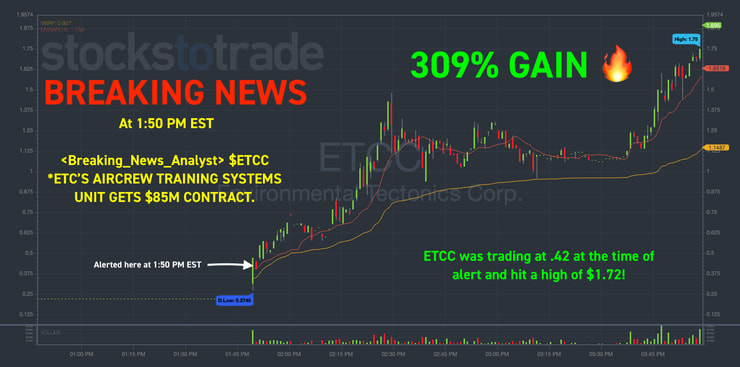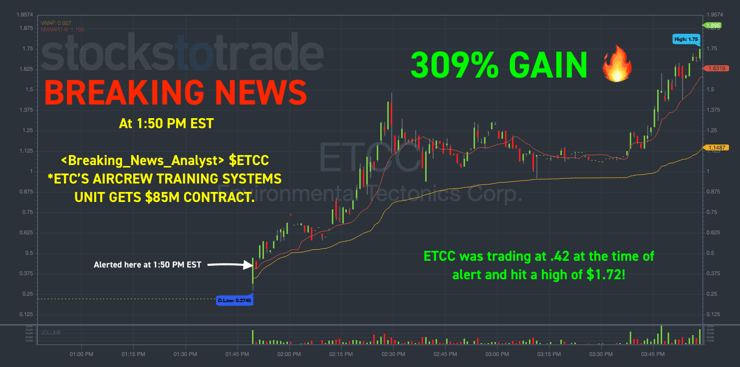No one likes to miss out on explosive moves, myself included.
After all, volatility is where the money is made.
Just look at this ridiculous move in Environmental Tectonics Corp. (OTC:ETCC) covered by our Breaking News Team:
However, the worst thing you can do is buy because of fear of missing out (AKA FOMO).
That’s a recipe for disaster.
The good news is that I can teach you how to balance the two rather easily, and it doesn’t take a degree in advanced mathematics or years of experience.
In fact, it’s one of the first lessons I teach students who take my Millionaire Challenge.
You see, most traders only care about gains, thinking about how much money they can make.
The reality is they rarely achieve the ‘maximum potential’ they calculate.
Shooting for unachievable targets keeps you in a trade for too long or with too much at stake.
Instead, I teach my students to think about every trade in terms of risk.
Their #1 goal: keep losses small and cut them fast.
Initially, this leads to a lot of small losses.
However, with experience, those same losses get smaller and smaller, even turning into small gains.
Because winners take care of themselves.
All this sounds great on paper, I’m sure.
So, let me prove it to you using my recent ETCC trade, where I caught a nice chunk of this beautiful runner.
Check out all my trades here on Profitly.
Breaking down breaking news
Virtually every one of my trades starts with a news catalyst.
As I mentioned before, I use our StocksToTrade Breaking News Chat – a team dedicated to quickly sifting through headlines to deliver only the relevant content traders need.
How fast are they?
You be the judge…
Click here for an exclusive trial offer
Now, I want to make two things very clear.
First, not all headlines are created equal.
There is news that’s material to a company, such as FDA approval, contracts, earnings, etc., and there’s non-material news, such as the CEO speaking at a conference or rehashing already-known press releases.
Learning to differentiate between these headlines is fundamental to penny stock trading. It’s so important that it’s a whole module in my Millionaire Challenge education.
Second, I don’t advocate buying a headline, even good ones, immediately.
As you’ll soon find out, there’s a method to how and where I enter these types of trades.
Keeping risk to a minimum
Let’s say you wanted to buy ETCC for a trade.
Here’s the 1-minute chart below.
Where would you buy it?
In my mind, there are only three potential spots: the two orange boxes and a break of the high (white line) near the close.
The two orange boxes highlight panic dips that I like to use for my entries.
A lot of folks think this is like catching a falling knife.
However, I teach my students how to read level 2 data, watch the price action, and strike when the moment is hot.
That’s exactly what I did here when I alerted students to my trade.
Buying on pullbacks provides me with a cushion of safety.
If the stock falls, then I’m already closer than the bottom than I would be if I had bought a breakout.
But more importantly, it falls into a pattern I see with these pumped-up names.
Buying panic dips gives me good entries that, when timed correctly, limit my potential losses.
You see, I’m not going to give this trade much rope to work.
If I don’t see price moving higher, I will cut it loose.
That’s partly why I exited where I did.
You can see that shares pulled back almost 10% off the highs.
I’m not looking to pick up the entire move, just the parts I find predictable.
Now, some traders will take a portion off at their first profit target, say 50%-75% of the trade, and leave a trailer on with a stop back at their entry.
That’s perfectly fine and a good way to catch as much of the move as possible.
It’s up to you and what you’re comfortable with.
Dip buying takes some practice. However, it’s my favorite setup and method to trade stocks.
It might look difficult, but once you join my Millionaire Challenge and start studying hard, you’ll quickly realize that it’s easier than you thought.
And all it takes is one setup to change everything.
–Tim








Leave a reply